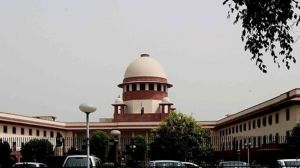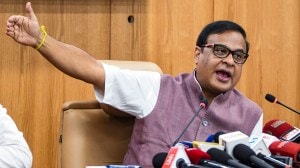Explained: Ukraine’s many revolutions in the past three decades, their impact
The Granite Revolution, the Orange Revolution, and the Maidan Revolution have played a part in shaping the Ukraine of today.
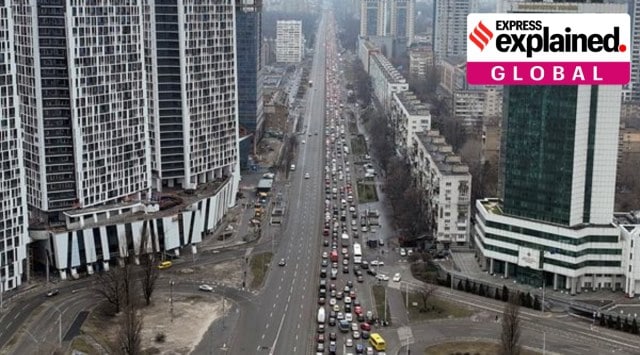 Traffic jams are seen as people leave the city of Kyiv, Ukraine, Thursday, Feb. 24, 2022. (AP)
Traffic jams are seen as people leave the city of Kyiv, Ukraine, Thursday, Feb. 24, 2022. (AP)Since 1990, Ukraine has had one revolution every decade. As Russian forces continue their long march into the former Soviet state, here is a look at some of these revolutions and their outcome.
Granite Revolution
Ukraine’s first and perhaps least known popular uprising was the granite revolution which took place in October 1990. At the time, Ukraine was still a part of the Soviet Union. However, the communist bloc was a waning power, and under Russian President Mikhail Gorbachev, also a relatively more tolerant one. Despite progress under Gorbachev, the stain of the Cold War ran deep, and the citizens of Ukraine were clamouring for change.
The revolution was led by a group of students who set up tents along the granite tiles that lined Kiev’s Independence Square, thus giving the movement the moniker by which it is known today. Having set up dozens of tents, students referred to their tent camp as “the territory free of communism.” Flags and posters were scattered across the square, with one declaring, “It is better to die than to live in the Soviet Union.”
The protesters made five demands, including that Ukraine depose its head of state and that it vote in favour of independence from the Soviet Union.
The Kremlin was taken back by the determination and coordination of the protests, unaccustomed as it was to any forms of domestic dissent. When several large marches were held in solidarity, and many workers’ organisations also rallied with the students, Moscow was at a loss of how to respond. Eventually, the demands were met and in 1991, Ukraine held a referendum for independence, with 90% of the electorate voting in its favour.
While contemporary history does not rate this revolution highly, primarily because it failed to bring about radical change or meaningful separation from the Soviet Union, given the context under which it took place, its significance ought not to be understated.
Before 1990, Ukraine had existed as an independent nation only a handful of times, most recently for a few years after World War One, and before that, for a brief period in the 1600s. The country had been under total or partial Russian rule for most of its history and consequently, a large number of Ukrainians felt a kinship with Russia and also spoke Russian. While a lot of people looked at Moscow fondly, with its shared sense of culture and heritage, others saw it as an oppressor that aimed to subjugate Ukraine.
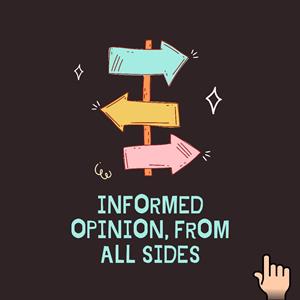 That disconnect would haunt Kiev for decades to come. Since it gained independence from the Soviet Union, Ukraine had played Russia and the West against each other, with alternating governments leaning one way or another, while ensuring to not antagonise either side.
That disconnect would haunt Kiev for decades to come. Since it gained independence from the Soviet Union, Ukraine had played Russia and the West against each other, with alternating governments leaning one way or another, while ensuring to not antagonise either side.
Soviet era officials remained in power and crucially, a giant Soviet hammer and sickle continued to loom over Independence Square until 2003, when it was removed in the months preceding Ukraine’s second revolution in as many decades.
Orange Revolution
The Orange Revolution was a series of protests and political events that took place in Ukraine between November 2004 and January 2005. The protests were prompted by several reports from foreign and domestic election monitors alleging that the country’s 2004 Presidential election runoff was rigged.
The two men at the centre of the controversy were then-Prime Minister Viktor Yanukovych, who was backed by the Kremlin, and Viktor Yushchenko, an ally of the West. The election commission had declared Yanukovych as the winner, despite strong condemnation from America and the EU, which considered the election to be illegitimate. Russia on the other hand claimed that it had seen no evidence of election fraud.
Following nationwide protests, the result was annulled, and the Ukrainian Supreme Court ordered a re-vote, which Yushchenko promptly won by a significant margin.
Under Yushchenko, Ukraine started drifting further towards the West. However, while the revolution succeeded in overturning the vote, it also exposed deep-rooted divisions in the country. The distribution of votes largely mirrored the east-west divide, with the Ukrainian-speaking west voting overwhelmingly for Yushchenko while the Russian-speaking east represented a Yanukovych stronghold. Today, the contested regions of Donetsk and Luhansk along with the annexed Crimean Peninsula lie on the eastern side of Ukraine, while the bastion of resistance, Kiev, is on the western side.
As we’re seeing now, those divisions would prove to be significant, with Putin’s underlying rationale behind the attacks predicated on the need to protect ‘ethnic Russians.’ However, in its immediate aftermath, the revolution seemed to signal the winds of change. Ukrainians that previously held a accommodating, if not favourable, view of Moscow suddenly seemed to resent the meddling of their powerful neighbour.
According to one report from the Brookings Institute, “the Ukraine of 2010 was a very different proposition to the country Yanukovych sought to rule six years earlier.”
The report points out that under Yushchenko, Ukraine embraced certain civil liberties that it had previously expunged. The media landscape became free of government control, fair elections became the norm and Ukraine increasingly seemed inclined to banish the shackles of its Soviet past. This in turn had massive ramifications for Russian policy.
According to the report, after the revolution, “Russia adopted a strikingly nationalistic course in domestic affairs, while becoming increasingly confrontational on the global stage.” Russian state-run media outlets blossomed, and with them, so did Russian propaganda. Moreover, Moscow became progressively hostile towards domestic dissent and actively began to bind youth closer to the regime.
Putin saw the changes afoot in Ukraine, and more than anything, feared that similar movements would take place in Russia. His focus thereafter was to crack down on the rights of speech and association. Ukraine however, remained ostensibly democratic and increasingly independent from Moscow, with its third revolution coming nearly a decade after the second.
Maidan Revolution
Like its past two revolutions, the Euromaidan protests were born out of a tug of war between Russia and the West over Ukraine. In 2010, Yanukovych defeated Yushchenko and assumed the position of Prime Minister. After coveting NATO partnership under Yushchenko, under Yanukovych, the pendulum of Ukrainian allyship swung back towards Russia.
In late November of 2013, the government in Kiev announced that it would suspend plans to sign an association union with the EU, choosing instead to form closer ties with Moscow. Protesters once again flocked to Independence Square but unlike the previous revolutions, which had been entirely bloodless, the Maidan revolution was to end in tragedy. Three months after protests began, security forces mounted attacks against demonstrators, eventually killing approximately 100 of them in the process.
Late in February 2014, the French, German and Polish Foreign Ministers arrived in Kiev to try and broker a settlement between Yanukovych and the opposition. However, immediately after signing the agreement, Yanukovych fled the country over fears for his own safety.
Those fears were not unfounded. Protestors saw Yanukovych as a Russian puppet and although he maintained strong support in Eastern Ukraine, he could not shake off allegations that the assault on protesters was demanded by the Kremlin in exchange for a USD 15 billion bailout package. Several government ministers from across Europe blamed Russia for exacerbating the violence but Putin remained defiant.
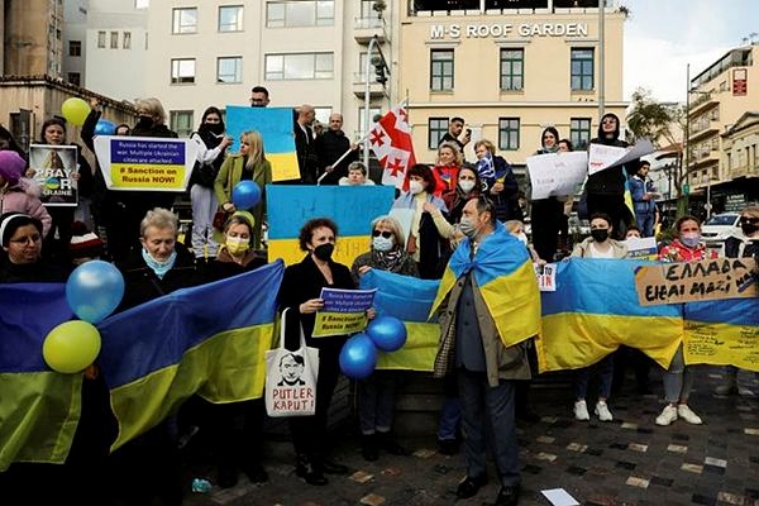 Ukrainians living in Greece hold Ukrainian flags and placards as they take part in a protest against Russia’s military operation in Ukraine, at Monastiraki square in Athens, Greece February 24, 2022. (Reuters)
Ukrainians living in Greece hold Ukrainian flags and placards as they take part in a protest against Russia’s military operation in Ukraine, at Monastiraki square in Athens, Greece February 24, 2022. (Reuters)
On February 22, the Ukrainian Parliament elected an acting Prime Minister who then declared his goals of bringing the country closer towards Europe. That proved to be a step too far for the Kremlin, which responded within a month by invading Ukraine and annexing the strategically significant port region of Crimea. Around the same time, fighting broke out in the Donbas, with alleged Ukrainian separatists demanding autonomy for the region.
Putin brazenly backed this movement, providing military resources in the Donbas and, according to some reports, covertly sending Russian soldiers to fight alongside the separatists.
Publicly, Putin maintained, as he does now, that he was simply protecting the interests of ethnic Russians and supporting their right to an autonomous state. However, one does not need to look deeply to realise the source of Russian concerns. A Ukraine that is firmly allied with the West is a Ukraine that is unacceptable to the Russian security apparatus.
As an added benefit, controlling the Donbas also gives Russia a land corridor that links it to Crimea. In the eight years that followed the civil war (according to Moscow) or the war against Russia (as maintained by Ukraine and the West), over 14,000 Ukrainians have been killed.
Some positives have emerged from the 2013 revolution, however. Importantly, the old guard is slowly being replaced, a phenomenon that is perhaps best represented by the election of Ukraine’s current Prime Minister, Volodymyr Zelensky, a former comedian and government outsider. Parliament also changed the constitution to limit the presidency and empower lawmakers, regulators abolished or nationalised more than half of Ukraine’s banks, and government functioning became far more transparent. Together, these reforms save Ukraine billions of dollars a year, even if corruption remains rampant in other areas.
Meanwhile, Ukraine has increased military cooperation with NATO, and spent billions on fixing its armed forces so that it may one day join the alliance. Trade with Russia has also declined with supply chains rerouted through Europe. An economy that is not wholly dependent on Russia, along with better military capabilities and closer relations with NATO, will be crucial advantages for Ukraine in the months to come. Most significantly, the attitudes of Ukrainians have changed considerably since the revolution. Polls after polls indicate that Ukrainians are more patriotic than ever before, and increasingly apprehensive and hostile towards Moscow.
Newsletter | Click to get the day’s best explainers in your inbox
A recent Kiev Institute of Sociology poll found that over 50 per cent of Ukrainians would resist Russian aggression either by taking up arms or by participating in civil disobedience. Prior to 2014, those numbers would have been considered optimistic folly.
Despite the turbulence of the last decade, Ukraine has made significant improvements to its governance, military capabilities, diplomatic relations and economy. This shift, brought on by decades of revolutions, could determine Ukraine’s fortunes in what can now, definitely, be called its war against Russia.





- 01
- 02
- 03
- 04
- 05












